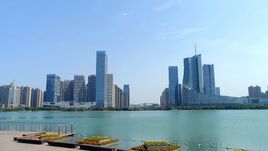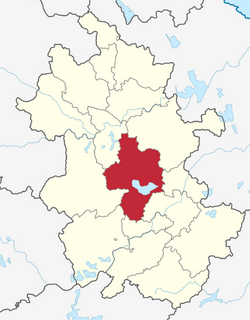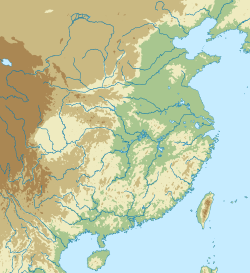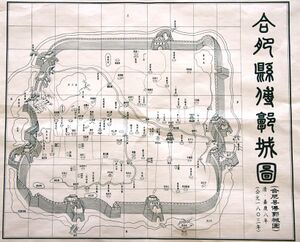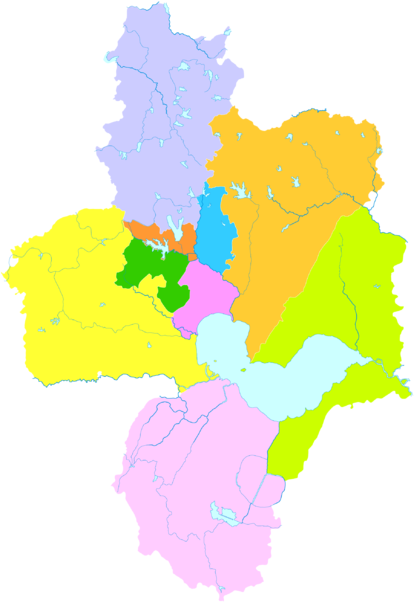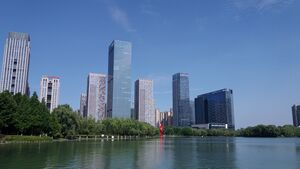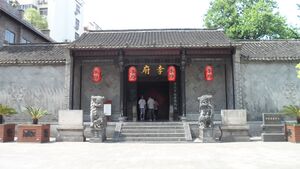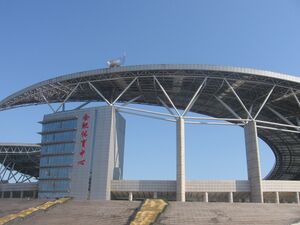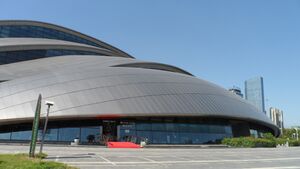خفي
| ||||||||||||||||||||||||||||||||||||||||||||||||||||||||||
| ||||||||||||||||||||||||||||||||||||||||||||||||||||||||||
خفي (الصينية: 合肥; پنين: Héféi; Wade–Giles: Ho-fei؛ حرفياً: "ثنية نهر فـِيْ (الجنوبي)"؛ إنگليزية: Hefei؛ الأسماء القديمة: Ho-fei, Luzhou, Luchow) هي مدينة صينية تقع على ضفاف المجرى الأدنى من نهر يانگتسي، وهي عاصمة مقاطعة آنهوي.[1] A prefecture-level city, it is the political, economic, and cultural center of Anhui. Its population was 7,965,300 as of 2017 sampling and its built-up (or metro) area made up of five urban districts plus Feidong and Changfeng counties being urbanized, was home to 6,173,000 inhabitants.[2] Located in the central portion of the province, it borders Huainan to the north, Chuzhou to the northeast, Wuhu to the southeast, Tongling to the south, Anqing to the southwest and Lu'an to the west. A natural hub of communications, Hefei is situated to the north of Chao Lake and stands on a low saddle crossing the northeastern extension of the Dabie Mountains, which forms the divide between the Huai and Yangtze rivers.[3]
The present-day city dates from the Song dynasty. Before World War II, Hefei remained essentially an administrative centre and the regional market for the fertile plain to the south. It has gone through a growth in infrastructure in recent years.[4] Hefei is the location of Experimental Advanced Superconducting Tokamak, an experimental superconducting tokamak magnetic fusion energy reactor.
Hefei is a world leading city for scientific research, with its ranking placed at 20th globally and 6th in China (behind Beijing, Shanghai, Nanjing, Guangzhou and Wuhan ), as tracked by the Nature Index in 2021.[5] The city is represented by several major universities, including the University of Science and Technology of China, Hefei University of Technology, Anhui University, Anhui Agricultural University and Anhui Medical University.[6] Notably, the University of Science and Technology of China is one of the top 100th comprehensive public research universities in the world.[7][8][9][10][11]
تعتبر مركزا صناعيا يصنع فيه تجهيزات الصناعة، والمواد الكيماوية، والتجهيزات المنزلية والمنتوجات النسيجية.
التاريخ
From the 8th to the 6th centuries BC, Hefei was the site of many small states, later a part of the Chu kingdom. Many archaeological finds dating from this period have been made. The name 'Hefei' was first given to the county set up in the area under the Han dynasty in the 2nd century BC.
In the 3rd century AD, the Battle of Xiaoyao Ford was fought at Xiaoyao Ford (逍遙津) in Hefei. Zhang Liao, a general of the Wei state, led 800 picked cavalry to defeat the 200,000-strong army from Wei's rival state Wu. Several decades of warring in Hefei between Wu and Wei followed this battle.
During the 4th to the 6th centuries AD, this crucial border region between northern and southern states was much fought over; its name and administrative status were consequently often changed. During the Sui (581–618) and Tang (618–907) periods, it became the seat of Lu prefecture—a title it kept until the 15th century, when it became a superior prefecture named Luzhou.
أسست المدينة أثناء عهد أسرة سونگ (960-1126)، the earlier Hefei having been some distance farther north. In the 10th year of Xining (熙宁, 1077 AD), the taxes collected from the Luchow Prefecture were 50315 Guan, approximately 25 million today's Chinese Yuan, with a ranking of the amount of taxes was the 11th(following Kaifeng, Hangzhou, Qinzhou, Chuzhou, Chengdu, Zizhou, Xingyuan, Mianzhou, Zhenzhou, Suzhou) among all the prefectures of Song Dynasty. During the 10th century, it was for a while the capital of the independent Wu kingdom (902–938) and was an important center of the Southern Tang state (937–975).
After 1127 it became a center of the defenses of the Southern Song dynasty (1126–1279) against the Jin (Jurchen) invaders in the Jin–Song wars, as well as a flourishing center of trade between the two states. When the Chinese Republic was founded in 1911, the superior prefecture was abolished, and the city took the name of Hefei. The city was known as Luchow or Liu-tcheou[12] (庐州, p Luzhou) during the Ming and Qing dynasties (after the 14th century to the 19th century). Hefei was the temporary capital for Anhui from 1853 to 1862. It was renamed as Hefei County in 1912. Following the Chinese victory in the Second Sino-Japanese War in 1945, Hefei was made the capital of Anhui.
Before World War II, Hefei remained essentially an administrative center and the regional market for the fertile plain to the south. It was a collecting center for grain, beans, cotton, and hemp, as well as a center for handicraft industries manufacturing cloth, leather, bamboo goods, and ironware.
The construction in 1912 of the Tianjin–Pukou railway, farther east, for a while made Hefei a provincial backwater, and much of its importance passed to Bengbu. In 1932–36, however, a Chinese company built a railway linking Hefei with Yuxikou (on the Yangtze opposite Wuhu) to the southeast and with the Huai River at Huainan to the north. While this railway was built primarily to exploit the rich coalfield in northern Anhui, it also did much to revive the economy of the Hefei area by taking much of its produce to Wuhu and Nanjing.
Although Hefei was a quiet market town of only about 30,000 in the mid-1930s, its population grew more than tenfold in the following 20 years. The city's administrative role was strengthened by the transfer of the provincial government from Anqing in 1945, but much of its new growth derived from its development as an industrial city. A cotton mill was opened in 1958, and a thermal generating plant, using coal from Huainan, was established in the early 1950s. It also became the seat of an industry producing industrial chemicals and chemical fertilizers. In the late 1950s an iron and steel complex was built. In addition to a machine-tool works and engineering and agricultural machinery factories, the city has developed an aluminum industry and a variety of light industries. Hefei's development was advanced by the Third Front construction.[13] It has since developed high-tech industries, including those involving semi-conductors and alternative energy.[13]
There are several universities based in the city. These include the University of Science and Technology of China, which is one of the best technological universities in the country.[13]
الجغرافيا
Hefei is located 130 كيلومتر (81 mi) west of Nanjing in south-central Anhui. Chao Lake, a lake 15 km (9 mi) southeast of the city, is one of the largest fresh water lakes in China. Though, the lake has unfortunately been polluted with nitrogen and phosphorus, in recent decades,[citation needed] the situation is improving due to efforts by both the government and the people.
المناخ
Hefei features a humid subtropical climate (Köppen Cfa) with four distinct seasons. Hefei's annual average temperature is 16.19 °C (61.1 °F). Its annual precipitation is just slightly over 1،000 ميليمتر (39 in), being heavier from May through August. Winters are damp and cold, with January lows dipping just below freezing and January averaging 2.8 °C (37.0 °F). The city sees irregular snowfalls that rarely turn significant .Springs are generally relatively pleasant if somewhat erratic. Summers here are oppressively hot and humid, with a July average of 28.3 °C (82.9 °F). In the months of June, July, August, and often September, daily temperatures can reach or surpass 37 °C (99 °F) with high humidity levels being the norm. Autumn in Hefei sees a gradual cooling and drying. With monthly percent possible sunshine ranging from 35 percent in March to 50 percent in August, the city receives 1,868 hours of bright sunshine annually. Extremes since 1951 have ranged from −20.6 °C (−5 °F) on 6 January 1955, to 41.1 °C (106 °F) on 27 July 2017.[14]
| بيانات المناخ لـ Hefei (1981–2010 normals) | |||||||||||||
|---|---|---|---|---|---|---|---|---|---|---|---|---|---|
| الشهر | ينا | فب | مار | أبر | ماي | يون | يول | أغس | سبت | أكت | نوف | ديس | السنة |
| القصوى القياسية °س (°ف) | 20.7 (69.3) |
27.5 (81.5) |
30.4 (86.7) |
34.7 (94.5) |
36.4 (97.5) |
37.8 (100.0) |
41.1 (106.0) |
41.0 (105.8) |
38.6 (101.5) |
34.7 (94.5) |
30.1 (86.2) |
22.5 (72.5) |
41.1 (106.0) |
| متوسط القصوى اليومية °س (°ف) | 6.9 (44.4) |
9.4 (48.9) |
14.4 (57.9) |
21.1 (70.0) |
26.6 (79.9) |
29.3 (84.7) |
32.2 (90.0) |
31.8 (89.2) |
27.8 (82.0) |
22.5 (72.5) |
16.0 (60.8) |
9.7 (49.5) |
20.6 (69.1) |
| المتوسط اليومي °س (°ف) | 2.8 (37.0) |
5.2 (41.4) |
9.8 (49.6) |
16.3 (61.3) |
21.8 (71.2) |
25.3 (77.5) |
28.3 (82.9) |
27.6 (81.7) |
23.3 (73.9) |
17.7 (63.9) |
11.0 (51.8) |
5.2 (41.4) |
16.2 (61.1) |
| متوسط الدنيا اليومية °س (°ف) | −0.3 (31.5) |
1.9 (35.4) |
6.1 (43.0) |
12.2 (54.0) |
17.6 (63.7) |
21.7 (71.1) |
25.2 (77.4) |
24.3 (75.7) |
19.8 (67.6) |
13.8 (56.8) |
7.1 (44.8) |
1.6 (34.9) |
12.6 (54.7) |
| الصغرى القياسية °س (°ف) | −20.6 (−5.1) |
−14.1 (6.6) |
−7.3 (18.9) |
−0.4 (31.3) |
6.2 (43.2) |
12.2 (54.0) |
17.9 (64.2) |
15.8 (60.4) |
10.8 (51.4) |
1.5 (34.7) |
−5.1 (22.8) |
−13.5 (7.7) |
−20.6 (−5.1) |
| متوسط تساقط الأمطار mm (inches) | 42.4 (1.67) |
52.3 (2.06) |
76.6 (3.02) |
81.4 (3.20) |
91.1 (3.59) |
142.9 (5.63) |
173.3 (6.82) |
126.0 (4.96) |
67.2 (2.65) |
57.4 (2.26) |
59.4 (2.34) |
30.8 (1.21) |
1٬000٫8 (39.41) |
| Average precipitation days (≥ 0.1 mm) | 8.2 | 8.9 | 11.6 | 10.3 | 10.2 | 10.6 | 12.1 | 11.0 | 7.8 | 8.5 | 7.6 | 6.0 | 112.8 |
| متوسط الرطوبة النسبية (%) | 75 | 74 | 72 | 71 | 71 | 76 | 80 | 81 | 77 | 74 | 74 | 73 | 75 |
| Mean monthly ساعات سطوع الشمس | 118.7 | 113.5 | 138.6 | 168.0 | 190.9 | 165.5 | 189.2 | 190.9 | 153.8 | 154.4 | 148.7 | 135.8 | 1٬868 |
| نسبة السطوع المحتمل للشمس | 38 | 37 | 35 | 42 | 44 | 41 | 46 | 50 | 43 | 46 | 48 | 46 | 43 |
| Source: China Meteorological Administration (precipitation days and sunshine 1971–2000)[15][16] | |||||||||||||
تلوث الهواء
Air quality typically diminishes in May and June when the city is blanketed by smog caused by the smoke generated as farmers outside the city burn their fields in preparation for planting the next crop.
التقسيمات الإدارية والسكان
السكان
The majority of the population in Hefei are Han Chinese. There are a comparatively small number of Hui Chinese living in the city, for whom a few mosques have been constructed. Of the more than five million people in the city, some are migrant workers from other parts of Anhui.
الإدارة
المدينة بمستوى محافظة خفي تدير 9 تقسيمات بمستوى ناحية، بما فيهم 4 مديريات، 1 ناحية-مدينة و 4 نواحي.
Hefei subdivisions area (km²), population (According to 2010 Census) and population density (per km²).[17]
| Map | ||||||||||||
|---|---|---|---|---|---|---|---|---|---|---|---|---|
| Division code[18] | English | Chinese | Pinyin | Area in km2[19] | Seat | Postal code | Subdivisions[20] | |||||
| Subdistricts | Towns | Townships | Ethnic townships | Residential communities | Villages | |||||||
| 340100 | Hefei | 合肥市 | Héféi Shì | 11434.25 | Shushan District | 230000 | 45 | 65 | 19 | 1 | 736 | 1102 |
| 340102 | Yaohai District | 瑶海区 | Yáohǎi Qū | 142.90 | Mingguang Road Subdistrict (明光路街道) | 230000 | 13 | 2 | 1 | 118 | 18 | |
| 340103 | Luyang District | 庐阳区 | Lúyáng Qū | 139.32 | Bozhou Road Subdistrict (亳州路街道) | 230000 | 11 | 1 | 84 | 14 | ||
| 340104 | Shushan District | 蜀山区 | Shǔshān Qū | 261.36 | Sanli'an Subdistrict (三里庵街道) | 230000 | 8 | 2 | 92 | 17 | ||
| 340111 | Baohe District | 包河区 | Bāohé Qū | 294.94 | Luogang Subdistrict (骆岗街道) | 230000 | 7 | 2 | 77 | 38 | ||
| 340121 | Changfeng County | 长丰县 | Chángfēng Xiàn | 1928.45 | Shuihu (水湖镇) | 231100 | 8 | 6 | 80 | 193 | ||
| 340122 | Feidong County | 肥东县 | Féidōng Xiàn | 2205.92 | Dianbu (店埠镇) | 231200 | 10 | 4 | 95 | 249 | ||
| 340123 | Feixi County | 肥西县 | Féixī Xiàn | 2082.66 | Shangpai (上派镇) | 231600 | 12 | 6 | 1 | 90 | 241 | |
| 340124 | Lujiang County | 庐江县 | Lújiāng Xiàn | 2347.48 | Lucheng (庐城镇) | 231500 | 17 | 38 | 194 | |||
| 340181 | Chaohu | 巢湖市 | Cháohú Shì | 2031.22 | Woniushan Subdistrict (卧牛山街道) | 238000 | 6 | 11 | 1 | 62 | 138 | |
الاقتصاد
As of 2021, the GDP of Hefei is ¥1,141.28 billion. The GDP per capita of the city is ¥121,187 (US$18,784), ranking within the top 20 of cities in China.[21]
Before the Chinese Civil War, Hefei's main industry was agriculture. After World War II, the capital of Anhui was moved from Anqing to Hefei. To assist the development of the city, many talented people were sent in from other parts of the country. Modern-day Hefei has machinery, electronics, chemistry, steel, textile, and cigarette industries, among others.
In 2008, the local government spent US$3.5 billion for a controlling ownership stake in BOE Technology (Jingdongfang).[13] BOE Technology subsequently grew to be one of the world's leading manufacturers of semiconductor products for telecommunications.[13]
Hefei has been identified by the Economist Intelligence Unit in the November 2010 Access China White Paper as a member of the CHAMPS (Chongqing, Hefei, Anshan, Ma'anshan, Pingdingshan and Shenyang), an economic profile of the top 20 emerging cities in China.[22]
Hefei was identified by The Economist in December 2012 as the world's No.1 fastest growing metropolitan economy.[23]
The local government invested heavily in NIO in order to integrate it with Hefei Changan Automobile, a legacy enterprise from the Third Front construction.[13] As of 2022, NIO is China's most successful electric vehicle manufacturer.[13]
الجامعات
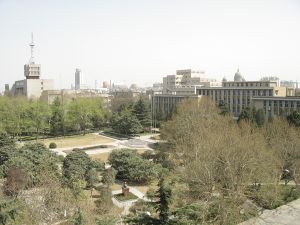
- University of Science and Technology of China (USTC)
- Hefei University of Technology (HFUT)
- Anhui University (AHU)
- Anhui Agricultural University (AHAU)
- Anhui Medical University (AHMU)
- Anhui University of Chinese Medicine (AUCM)
- Anhui Jianzhu University (AHJU)
- Hefei Normal University (HNU)
- Hefei University (HU)
- Beihang University (BUAA) – Hefei Campus
- National University of Defense Technology (NUDT) – Hefei Campus
- Beijing Foreign Studies University (BFSU) – Hefei Campus
- Tianjin University (TJU) – Hefei Graduate School
- Peking University (PKU) – Hefei Graduate School
- Tsinghua University (THU) – Hefei Institute of Public Safety Research
سجن ييتشنغ
Yicheng Prison is located within the city. It was built during the 1983 "Strike Hard" campaign and was formerly Hefei Zhenxing Machine Parts Factory. On 15 June 1984, the Prov. Justice Dept. decided to change the name of the Machine Parts Factory's Internal Dept. to the Prov. Independent LRC. On 17 March 1986, the city's Party Committee and government agreed to the change. On 26 April more than 400 inmates were transferred to Hefei Shangzhangwei Farm and Baihu Farm. In February 1992 a secondary country level prison was created at the Shangzhangwei Farm. In August 1992 the Hefei City LRD level was upgraded by the government. June 1996 the prison was changed to its present name. It is currently controlled by Hefei city. It mainly houses prisoners with sentences of less than 5 years and houses up to 1000 prisoners a year. In the past 20 years, nearly 20,000 inmates have completed their sentences here. The prison mainly cultivates vegetables and rice but also cooperates with the Zhejiang Rongguang Group and produces soccer training shoes, soccer balls, tourism products, and other products.[24]
المعالم
- Sanhe Town, ancient town which has a history of more than 2,500 years.
- Xiaoyaojin Park, a public park sitting on the ancient site of the Battle of Xiaoyao Ford.
- Temple of Lord Bao, built in 1066 near the tomb of Lord Bao.
- Li Hongzhang's Former Residence (الصينية: 李鸿章故居; پنين: Lǐhóngzhāng gùjū), built in the late 19th century and fully restored by the 1990s.
- Hui Garden (الصينية: 徽园; پنين: Huī yuán) (Opened to the public in September 2001)
- Children's Welfare Institute (a.k.a. "Social Welfare Institute"), children's orphanage
- Anhui Laomingguang Stadium, the home ground of Anhui Jiufang, but also used for other public sporting events.
- Hefei Olympic Sports Center Stadium, football stadium with a capacity of 60,000 people
- Hefei Grand Theatre, opera house
العلاقات الدولية
البلدات التوأم — المدن الشقيقة
خفي متوأمة مع:
 Kurume, Japan (May 20, 1980)
Kurume, Japan (May 20, 1980) Freetown, Sierra Leone (March 20, 1984)
Freetown, Sierra Leone (March 20, 1984) Bujumbura, Burundi (July 7, 1986)
Bujumbura, Burundi (July 7, 1986) Columbus, Ohio, United States (November 17, 1988)
Columbus, Ohio, United States (November 17, 1988) Aalborg, Denmark (April 22, 1989)[25]
Aalborg, Denmark (April 22, 1989)[25] Lleida, Spain (April 4, 1998)
Lleida, Spain (April 4, 1998) Wonju, South Korea (June 20, 2002)
Wonju, South Korea (June 20, 2002) Darebin, Australia (October 29, 2003)
Darebin, Australia (October 29, 2003) Belfast, Northern Ireland, United Kingdom (December 26, 2003)
Belfast, Northern Ireland, United Kingdom (December 26, 2003) Rostock, Germany (May, 2010)[26]
Rostock, Germany (May, 2010)[26]
أشخاص بارزون
- Bao Zheng (999–1062), Northern Song Dynasty bureaucrat and judge whose name has become synonymous with judicial wisdom and uprightness.
- Chen Ning Yang, (و. 1922), 1957 Nobel Physics Prize laureate, one of the two earliest Chinese to receive the prize.
- Li Hongzhang (1823–1901), prominent late Qing Dynasty bureaucrat and diplomat.
- Duan Qirui (1865–1936), the Provisional Chief Executive of Republic of China (in Beijing) from November 24, 1924 to April 20, 1926.
- Yang Yuanqing (و. 1964), Chairman of Board of Lenovo.
- Liu Mingchuan (1836–1896). Statesman during the late Qing Dynasty, first governor of Taiwan.
- Jin Jing (و. 1981), paralympic fencer.
المدن الشقيقة
 Kurume, Fukuoka, Japan (1980)[27]
Kurume, Fukuoka, Japan (1980)[27] Freetown, Sierra Leone (1984)
Freetown, Sierra Leone (1984) Bujumbura, Burundi (1986)
Bujumbura, Burundi (1986) Columbus, Ohio, United States (1988)[28]
Columbus, Ohio, United States (1988)[28] Aalborg, Denmark (1989)
Aalborg, Denmark (1989) Lleida, Catalonia, Spain (1998)
Lleida, Catalonia, Spain (1998) Wonju, Gwandong, South Korea (2002)
Wonju, Gwandong, South Korea (2002) Darebin, Victoria, Australia (2003)
Darebin, Victoria, Australia (2003) Belfast, Northern Ireland, United Kingdom (2005)
Belfast, Northern Ireland, United Kingdom (2005) Osnabrück, Lower Saxony, Germany (2006)
Osnabrück, Lower Saxony, Germany (2006) Ufa, Bashkortostan, Russia (2016)[29]
Ufa, Bashkortostan, Russia (2016)[29]
الهامش
- ^ "Illuminating China's Provinces, Municipalities and Autonomous Regions". PRC Central Government Official Website. Archived from the original on 2013-12-09. Retrieved 2014-05-17.
- ^ "China: Ānhuī (Prefectures, Cities, Districts and Counties) - Population Statistics, Charts and Map".
- ^ "Hefei | China". Encyclopedia Britannica (in الإنجليزية). Archived from the original on 2019-03-27. Retrieved 2019-06-14.
- ^ "The Economist Intelligence Unit". country.eiu.com. Archived from the original on 2019-11-12. Retrieved 2019-06-14.
- ^ "Nature Index 2021 Science Cities | Supplements | Nature Index". www.natureindex.com. Retrieved 2021-09-28.
- ^ "US News Best Global Universities Rankings in Hefei". U.S. News & World Report. 2021-10-26. Retrieved 2021-10-30.
{{cite web}}: CS1 maint: url-status (link) - ^ "QS Ranking: University of Science and Technology of China". Top Universities (in الإنجليزية). 2015-07-16. Retrieved 2020-12-06.
- ^ "Institution outputs | Nature Index". www.natureindex.com. Retrieved 2020-10-10.
- ^ "University of Science and Technology of China". Times Higher Education (THE) (in الإنجليزية). 2020-09-17. Retrieved 2020-10-13.
- ^ "University of Science and Technology of China". NTU Ranking. Retrieved 2020-10-13.
- ^ "World University Rankings - 2020 | China Universities in Top 1000 universities | Academic Ranking of World Universities - 2020 | Shanghai Ranking - 2020". www.shanghairanking.com. Retrieved 2020-12-06.
- ^ Inter alia: Mitchell Sr., S.A. A New Universal Atlas Containing Maps of the various Empires, Kingdoms, States and Republics Of The World. "China. Archived 2012-06-29 at the Wayback Machine" Entered 1850, Published 1853.
- ^ أ ب ت ث ج ح خ Marquis, Christopher; Qiao, Kunyuan (2022). Mao and Markets: The Communist Roots of Chinese Enterprise. New Haven: Yale University Press. doi:10.2307/j.ctv3006z6k. ISBN 978-0-300-26883-6. JSTOR j.ctv3006z6k. OCLC 1348572572. S2CID 253067190.
- ^ "无标题文档". Archived from the original on 18 March 2013. Retrieved 1 January 2014.
- ^ 中国气象数据网 – WeatherBk Data (in Chinese (China)). China Meteorological Administration. Retrieved 15 April 2020.
- ^ 中国地面国际交换站气候标准值月值数据集(1971-2000年). China Meteorological Administration. Archived from the original on 21 September 2013. Retrieved 25 May 2010.
- ^ (صينية) Compilation by LianXin website. Data from the Sixth National Population Census of the People's Republic of China
- ^ 国家统计局统计用区划代码 (in Chinese (China)). National Bureau of Statistics of the People's Republic of China. 2011. Archived from the original on 2013-04-05. Retrieved 2018-01-02.
- ^ 《合肥统计年鉴2011》
- ^ 《中国民政统计年鉴2011》
- ^ National Bureau of Statistics of China
- ^ "THE RISE OF THE 'CHAMPS' – NEW REPORT MAPS BUSINESS OPPORTUNITY IN CHINA'S FASTEST GROWING CITIES". Archived from the original on 6 April 2012. Retrieved 5 January 2018.
- ^ "Metro economies". The Economist. 4 December 2012. Archived from the original on 25 September 2017. Retrieved 5 January 2018.
- ^ "Laogai Handbook 2007–2008" (PDF). Laogao.it. Archived (PDF) from the original on 28 February 2012. Retrieved 18 June 2015.
- ^ "Aalborg Twin Towns". Europeprize.net. Retrieved 19 August 2013.
- ^ "Hefei Cooperates with Rostock". hefei.gov.cn. Retrieved 2012-12-18.
- ^ 友好都市. Kurume city. Archived from the original on 2015-02-24. Retrieved 2015-02-24.
- ^ "Hefei, China – Columbus Sister Cities". columbussistercities.com. Archived from the original on 2018-07-05. Retrieved 2018-07-24.
- ^ 合肥市缔结友好城市关系情况一览表. hfwqb.hefei.gov.cn. Archived from the original on 2017-12-01. Retrieved 2019-02-03.
وصلات خارجية
| أكبر مدن أو بلديات في جمهورية الصين الشعبية
China Urban Construction Statistical Yearbook 2020 Urban Population and Urban Temporary Population | |||||||||
|---|---|---|---|---|---|---|---|---|---|
| الترتيب | المقاطعة | التعداد | الترتيب | المقاطعة | التعداد | ||||
 شنغهاي  بكين |
1 | شنغهاي | SH | 24,281,400 | 11 | Hong Kong | HK | 7,448,900 |  Guangzhou  Shenzhen |
| 2 | بكين | BJ | 19,164,000 | 12 | Zhengzhou | HA | 7,179,400 | ||
| 3 | Guangzhou | GD | 13,858,700 | 13 | Nanjing | JS | 6,823,500 | ||
| 4 | Shenzhen | GD | 13,438,800 | 14 | Xi'an | SN | 6,642,100 | ||
| 5 | Tianjin | TJ | 11,744,400 | 15 | Jinan | SD | 6,409,600 | ||
| 6 | Chongqing | CQ | 11,488,000 | 16 | Shenyang | LN | 5,900,000 | ||
| 7 | Dongguan | GD | 9,752,500 | 17 | Qingdao | SD | 5,501,400 | ||
| 8 | Chengdu | SC | 8,875,600 | 18 | هاربين | HL | 5,054,500 | ||
| 9 | ووهان | HB | 8,652,900 | 19 | Hefei | AH | 4,750,100 | ||
| 10 | Hangzhou | ZJ | 8,109,000 | 20 | Changchun | JL | 4,730,900 | ||
- CS1 maint: url-status
- CS1 uses الصينية-language script (zh)
- CS1 Chinese (China)-language sources (zh-cn)
- Articles containing صينية-language text
- CS1 uses اليابانية-language script (ja)
- Short description is different from Wikidata
- Pages using multiple image with auto scaled images
- Pages using gadget WikiMiniAtlas
- Articles containing Chinese-language text
- Articles containing إنگليزية-language text
- Pages using Lang-xx templates
- Articles containing simplified Chinese-language text
- Articles with unsourced statements from December 2015
- Articles with hatnote templates targeting a nonexistent page
- خفي
- عواصم المقاطعات في الصين
- صفحات مع الخرائط
